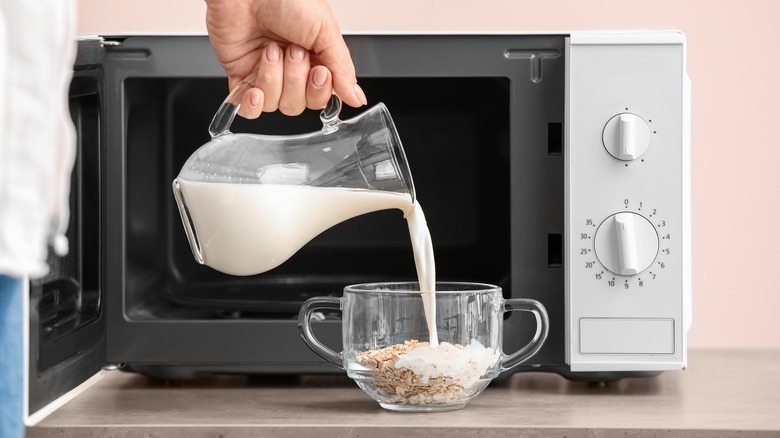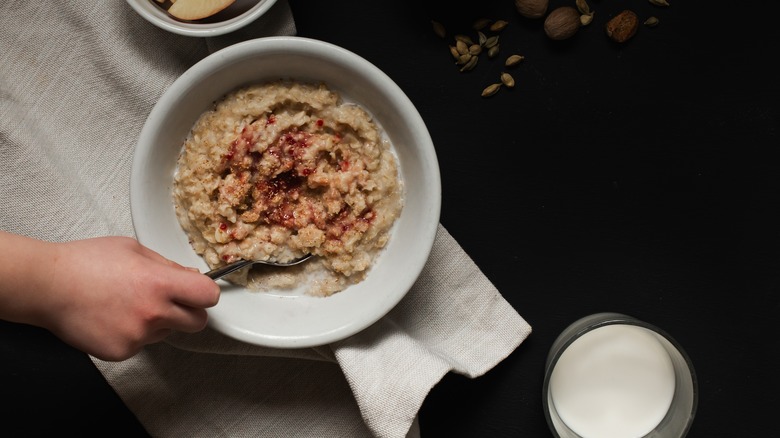Forget The Stovetop, Here's Why Microwaving Your Oatmeal Is Actually The Best Way To Go
If you're looking for a hearty meal, whether sweet or savory, nothing warms you — and fills you — up like a bowl of freshly made oatmeal. While many recipes, like Bobby Flay's easy go-to oatmeal, call for it to be cooked on a stovetop, it might be that the microwave is actually the better appliance for making creamy, dreamy oatmeal. Marissa Stevens, recipe developer and food blogger at Pinch and Swirl, spoke with us at Food Republic and told us, "Honestly, I was a microwave oatmeal skeptic until about five years ago. But now it's my favorite way to cook [oats] on busy mornings."
She continued, "Beyond the obvious time savings, microwaving actually preserves the texture better than stovetop cooking. The heat is gentler and more even, so the oats don't break down as much." Stevens said she's done side-by-side tests — the microwaved oatmeal kept its "more distinct texture" better, which makes sense. There's a reason we advise skipping boiling liquid for superior oatmeal, after all. "Cleanup is easier too," Stevens enthused. "Just one bowl instead of scrubbing a pot with that ring of dried oatmeal stuck to the sides." Finally, Stevens also appreciates that she can make a single serving more easily.
How to microwave oatmeal to perfection
"I've found a 1:2 ratio works best for microwaved rolled oats — that's one part oats to two parts liquid," Marissa Stevens told us. "It's a bit less than you'd use on the stovetop because less evaporates." For your liquid, you can use water, but it will leave your oatmeal tasting pretty bland, even with mix-ins. Instead, try milk, especially plant-based varieties like almond or oat milk, as those will also increase the creaminess.
Next, Stevens said she uses a half cup of old-fashioned rolled oats with one cup of liquid (obviously you can multiply that ratio based on however much oatmeal you want to make). "Here's my exact method," she continued. "Microwave on high for [two] minutes, then let it stand for a minute before stirring." If your oatmeal becomes too thick, you can thin it by adding a splash of your liquid of choice. Alternatively, enhance the flavor and creaminess of your oats by using your favorite coffee creamer.
From there, you can dress the oatmeal up however you like. If you're used to flavored instant oatmeal, you'll probably want to sweeten it. You can use sugar, but you might instead try brown sugar, honey, maple syrup, or even a mashed banana or applesauce. You can also eat it as a savory dish, topping it with a fried egg or sliced avocado, parmesan cheese, crumbled bacon, caramelized onions — the list goes on. Oats are a blank canvas waiting for your creativity.
A few tips for making oatmeal in the microwave
There were a few tips Marissa Stevens wanted to impart, especially to first-time oatmeal makers. "First, use a MUCH bigger bowl than you think necessary," she cautioned. "The oats bubble up dramatically, especially in the last 30 seconds." If you can find a bowl that's taller than it is wide, like some ramen bowls, that would be ideal — though you will still want to keep an eye on your oatmeal as it cooks.
"Second," Stevens continued, "don't just zap it for the full time. Cook for 90 seconds, stir, then another [30 to 60] seconds depending on how powerful your microwave is." In addition to ensuring the oats cook evenly, it also helps keep everything from bubbling over (seriously, you do not want this to happen, because if you don't clean it up right away, the mixture will harden into a sticky, stuck-on mess).
Finally, Stevens suggested, "Let it stand for a minute afterward. This isn't just about cooling down; this rest time allows the oats to absorb the last bit of liquid and reach the perfect consistency." You might be surprised at how soupy your oatmeal is as soon as it's done in the microwave — but then, after just a minute, how quickly it thickens up.



